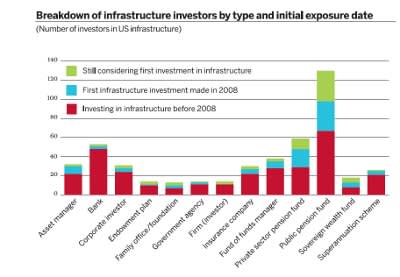As the US's bridges and roads show their age, the country's government is scrambling to attract capital and jump-start development. The need is huge. Over the next five years, an estimated $2000bn in financing will be required to fix the US's crumbling infrastructure.
Investors, attracted by the low-risk, double-digit returns associated with the infrastructure sector, are eager to participate, as are banks - despite being burned by the credit crisis and political gridlocks. In 2006 and 2007, many banks revved up their infrastructure capacity, anticipating huge expansion in this space. However, they are still waiting for this expansion - even as investor money gathers in the sidelines.
According to research and consultancy firm Preqin, the number of North American investors in unlisted infrastructure funds has increased by 37% since the end of 2007. Today, this group makes up 29% of the global investor base - still a minority, but one that is growing. Investor interest is also evident in a US Pensions & Investments' survey carried out last year, which shows infrastructure investments up 270%, to $2.28bn, putting it among the 200 largest retirement funds for 2008.
Much of this money continues to flow overseas because of a lack of viable investment opportunities in the US, at least in transportation, which is a key part of the infrastructure sector. At federal and local level, US governments have tended to shun private capital alternatives - the lifeblood of infrastructure development in western Europe and Canada - because of reluctance to put US roads and bridges in private, or foreign, hands. US governments have also been unwilling to raise revenues by hiking tolls charged on highways, one of the few current alternatives for obtaining funding.
"In the US, the biggest issue has always been crumbling infrastructure and no dollars to [rebuild] it," says Craig Fuehrer, managing director of Deutsche Bank's transportation investment banking group. "There's a lack of political will to raise [road] tolls and fees."
Air of caution
Despite political roadblocks, many are banking on the US's overwhelming need to kick-start the infrastructure sector somewhere, somehow. Based on positive rumblings from the government a couple years ago, banks thought that this time had come and prepared themselves for an infrastructure boom, but the credit crisis slammed the brakes on these hopes. As a result, banks cut back and found themselves stuck with loans priced at inflated pre-crash values.
"Everyone in Europe and the US is down," says one Wall Street banker. "Loan-to-values on these infrastructure deals in 2006 and 2007 were at record highs with thin debt coverage. So a lot of these loans are in trouble, which is why banks have decreased their willingness to lend. Banks love the business - the problem is that their holdings have been beaten up dramatically."
As markets have struggled in the past two years, the global infrastructure sector has turned round 180 degrees, says Jonathan Turnbull, global head of infrastructure investment banking at Citigroup. "Just a few years ago you could find four to five banks that could step up for billion-dollar positions." Now, those same banks have cut back to allocations of $50m to $75m.
That said, there are nascent signs of healing. "Once again there is growing competition among banks and institutional debt investors for infrastructure and project finance debt," says Jonathan Yellen, who oversees Deutsche Bank's infrastructure and project finance activities in North America. "As a result, we've seen a tightening of bond spreads, a lengthening of tenors in bank loans, and a shortening of execution timeframes for these transactions."

Jonathan Turnbull, global head of infrastructure banking, Citigroup

Craig Fuehrer, managing director of the transportation investment banking group, Deutsche Bank
Private capital
Political change is also in the air. Over the past few months, faced with crippling budget crises and few alternatives, 25 states have passed legislation allowing public private partnerships (PPPs) - a model that has long been core to infrastructure finance overseas. PPPs are a comprehensive risk-sharing agreement in which a government contracts with a private company to finance an infrastructure project. So far, the model has been used successfully in a number of projects, including the Chicago Skyway and the Indiana Toll Road, which have been leased to private firms for large upfront payments. Massachusetts, Florida and New York are considering similar deals.
These successes, however, come after some spectacular failures. One of these is the Pennsylvania Turnpike deal - the largest public-private transportation partnership proposed in US history - which collapsed in 2008. The project aimed to lease 800 kilometres of the Pennsylvania Turnpike to a private partnership for 75 years in exchange for $12.8bn upfront. The private consortium dropped its offer as bickering law-makers dragged their heels. Another casualty was a $2.5bn agreement to sell Chicago's Midway Airport, which fell apart when investors could not raise enough money.
Some say the US government has been slow to adopt Europe's model because it has traditionally leaned on the municipal bond market and wanted to keep a grip on its public assets. That mentality is changing, albeit slowly.
The US has historically favoured a more traditional approach to project implementation, because conventional wisdom said tax-free municipal bonds had a structural rate advantage over traditional corporate borrowings, says Steve Beatty, chairman of KPMG's Global Infrastructure & Projects Group. While the rate on the debt may be lower, he says many in the US are realising that this is only part of the consideration.
"Leading jurisdictions have begun to use the total cost approach. The total cost of finance is the product of the rate and the amount financed," says Mr Beatty.
As more decision-makers think along these lines, more deals should get done. There are signs this is already happening. "My phone is definitely ringing," says Arthur Simonson, managing director of corporate and government ratings at Standard & Poor's. "I'm getting more calls from bankers wanting to talk about potential PPPs or different projects, such as water desalination plants, power facilities, toll roads, some solar power projects and wind power projects and electricity transmission lines."
Mr Simonson says the banks are assessing critical items from a credit perspective. "So many entities have put these projects on hold; and you can only put infrastructure on hold for so long. There's definitely a lot more inquiries now compared to the end of 2008 and 2009." The size of infrastructure transactions typically starts at $150m and goes up quickly from there, he adds.

Breakdown of infrastructure investors by type and initial exposure date (Number of investors in US infrastructure)

Breakdown of infrastructure investor by location and initial exposure date (Number of investors in US infrastructure)
New deals
In recent months, some new deals have attracted strong demand, including Southeast Supply Header, a Delaware limited liability company that owns and operates a 440-kilometre natural gas transportation system, and which closed a private offering of $375m of 4.85% senior notes in August. Deutsche Bank was one of the bookrunners. The issue was followed by another pipeline deal in September, when Midcontinent Express Pipeline issued $800m in five-year and 10-year notes.
Despite such signs of life, lenders suggest the markets will likely be slower to adopt PPP vehicles. "People have learned that with structures such as PPPs, there are a lot of hoops that need to be jumped through at all levels of government. Our view is that there will be more PPPs and assets to sell, but it will take time," says Citi's Mr Turnbull.
As US bankers wait for these structures to gain traction, they are focused on other opportunities besides PPPs, which tend to focus on transportation assets such as toll roads, airports, ports and car parking. Some like infrastructure assets in the utility/power/energy sector, which is more fragmented in the US than most other markets. And this creates opportunities to acquire low-risk and attractive assets. The sector's capital base is strong, with many billions of dollars in debt and equity capital sold each year.
US banks have also focused on opportunities to monetise tax advantages offered by the US government through renewable energy projects - one of the few areas in the infrastructure sector where US banks actually have an advantage over European counterparts. Those with expertise are taking advantage of these tax benefits to obtain attractive returns, thanks to a scarcity of capital in this sector. European banks have been limited by comparison because they are not eligible for the same tax breaks, given their lack of a US tax equity base.

Jonathan Yellen, oversees Deutsche Bank's infrastructure and project finance activities in North America
Ready for take-off
Meanwhile, the take-off of PPPs is being keenly anticipated in the US. When that happens, many experts believe that the country's banks will give their European counterparts a run for their money.
"As the US financing community figures out PPPs, it will begin to lead consortiums providing debt. The current market leaders in innovative finance [European banks] will face powerful new competitors," says KPMG's Mr Beatty. "Public leadership will begin the change to innovative finance. Domestic developers and constructors will emerge and financiers will be fast to respond."
Bankers say they are ready to run. According to Deutsche's Mr Yellen: "There's no shortage of private debt and equity capital to finance private infrastructure around the globe. There's lots of money backing infrastructure private equity funds. The bond and bank markets for infrastructure and project finance debt are both quite healthy."












